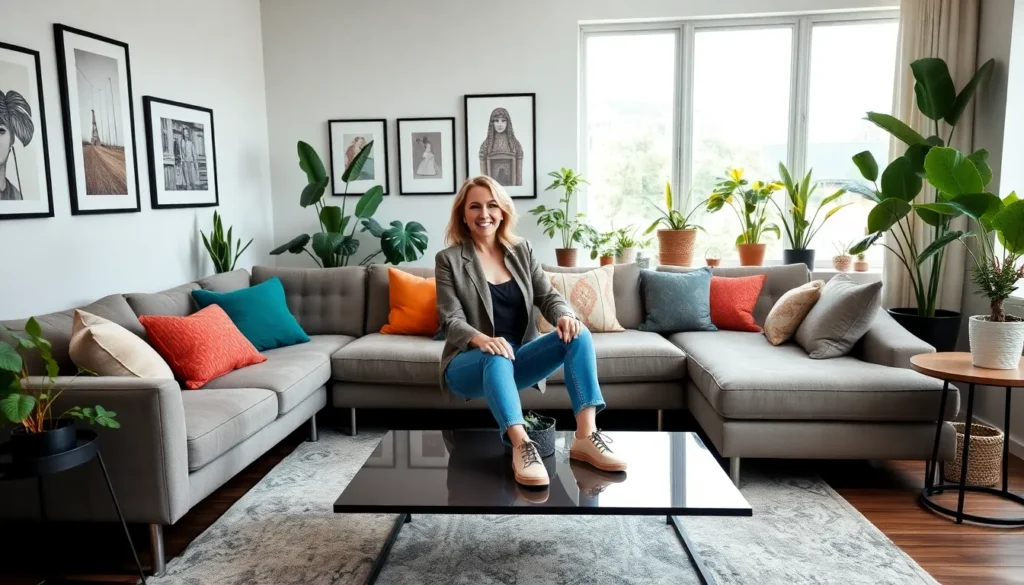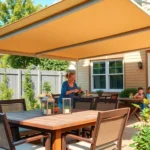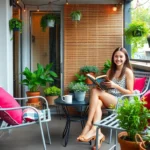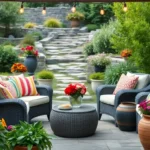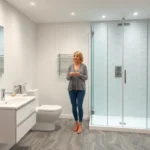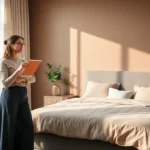We’ve all stared at our living rooms wondering how to transform them into the stunning spaces we see in magazines. Whether you’re working with a cramped apartment or a spacious family room your living space deserves to reflect your personality while maximizing both style and functionality.
The living room serves as the heart of our homes where we entertain guests unwind after long days and create lasting memories with loved ones. That’s why getting the design right matters more than you might think. From choosing the perfect color palette to arranging furniture that promotes conversation every decision impacts how we feel in this essential space.
We’ll explore fresh design ideas that work for every budget and lifestyle. You’ll discover how simple changes like strategic lighting bold accent walls and smart storage answers can completely revolutionize your living room without very costly.
Choose a Cohesive Color Palette That Reflects Your Style
Creating a unified color scheme serves as the foundation for any successful living room design. We’ll guide you through establishing colors that work harmoniously while expressing your unique personality.
Select a Primary Color Scheme
Start with a base palette of 2-3 main colors that will dominate your living room design ideas. Neutral tones like warm grays, soft beiges, or crisp whites create versatile backdrops that stand the test of time. Bold primary colors such as navy blue, forest green, or charcoal work beautifully for homeowners who prefer dramatic statements.
Consider your existing furniture pieces when selecting your primary scheme. We recommend choosing colors that complement rather than compete with major investments like sofas, area rugs, or built-in shelving. Monochromatic schemes using varying shades of one color create sophisticated depth while maintaining visual calm.
Test paint samples on different walls throughout the day to see how natural light affects your chosen colors. Many designers suggest the 60-30-10 rule: use your dominant color for 60% of the room, a secondary color for 30%, and an accent color for the remaining 10%.
Incorporate Accent Colors Through Accessories
Introduce pops of color through easily changeable elements like throw pillows, artwork, or decorative objects. Accent colors should complement your primary palette while adding visual interest and personality to your living room design. We suggest limiting accent colors to 1-2 shades to maintain cohesion.
Seasonal accessories offer flexibility to refresh your space without major renovations. Warm oranges and deep reds work well for autumn, while cool blues and fresh greens brighten spring and summer months. Gallery walls provide excellent opportunities to incorporate multiple accent colors through varied artwork and frames.
Plants serve as natural accent pieces that introduce vibrant greens while improving air quality. Metallic accessories in gold, silver, or copper add glamour and can bridge different color temperatures within your palette.
Consider the Psychology of Color in Your Space
Understanding how colors affect mood helps create the atmosphere you want in your living room. Cool colors like blues and greens promote relaxation and tranquility, making them ideal for spaces where you unwind after long days. Warm colors such as reds, oranges, and yellows stimulate conversation and energy, perfect for entertainment areas.
Earth tones including browns, taupes, and terracottas create grounding, comfortable environments that feel naturally inviting. We find these colors particularly effective in living rooms where families gather regularly. Purple shades can add luxury and creativity, while yellow brings cheerfulness and optimism to darker spaces.
Room size influences color psychology as well. Light colors make small living rooms feel more spacious, while darker hues create intimate, cozy atmospheres in larger spaces. Consider your room’s natural light exposure when applying color psychology principles to achieve your desired emotional response.
Maximize Natural Light to Brighten Your Space
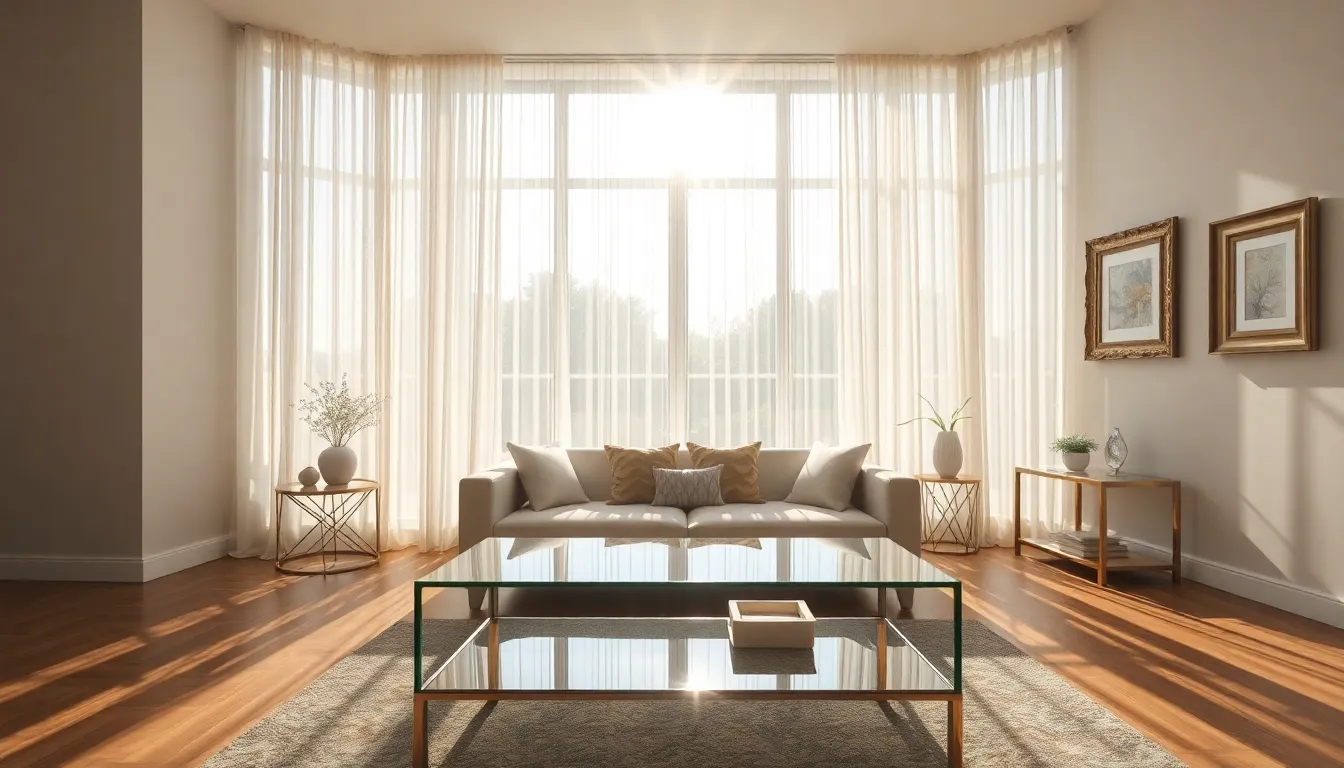
Building on your carefully chosen color palette, we’ll now explore how natural light can amplify your living room’s beauty and create the bright, welcoming atmosphere you’ve worked to achieve.
Position Mirrors Strategically to Reflect Light
Mirror placement opposite windows creates the most dramatic impact for amplifying sunlight throughout your living room. We recommend placing large mirrors directly across from your primary light sources to reflect and distribute brightness across the entire space. This simple technique creates the illusion of a larger, more airy environment while doubling the natural light entering your room.
Reflective surfaces beyond mirrors enhance your lighting strategy by incorporating light-colored walls and glossy finishes throughout the space. We suggest using metallic picture frames, glass coffee tables, and polished hardware to create multiple reflection points. These elements work together to bounce light around the room, eliminating dark corners and creating a cohesive bright atmosphere.
Choose Light-Colored Window Treatments
Sheer curtains and light-filtering blinds maximize sunlight entry while maintaining the privacy your living room requires. We prefer these options because they allow soft, diffused light to enter throughout the day without blocking your carefully planned natural lighting. White, cream, or pale neutral treatments complement most color schemes while ensuring maximum light transmission.
Motorized window treatments offer adjustable light control that adapts to your daily needs and seasonal changes. We find these systems particularly valuable for maintaining consistent lighting levels throughout the day. You can program them to open gradually in the morning and adjust throughout the day, ensuring optimal natural light without overwhelming your space.
Remove Obstacles That Block Natural Light Sources
Furniture placement away from windows ensures unobstructed light flow throughout your living room design. We recommend positioning sofas, bookcases, and tall furniture pieces at least 18 inches away from window areas. This creates clear pathways for sunlight while maintaining functional furniture arrangements that support conversation and daily activities.
Regular window cleaning maximizes light transmission and maintains the brightness you’ve worked to achieve. We suggest cleaning windows monthly from both inside and outside to remove dust, fingerprints, and weather buildup. Clean windows can increase natural light by up to 25%, making this simple maintenance task crucial for your bright living room goals.
Create Functional Zones for Different Activities
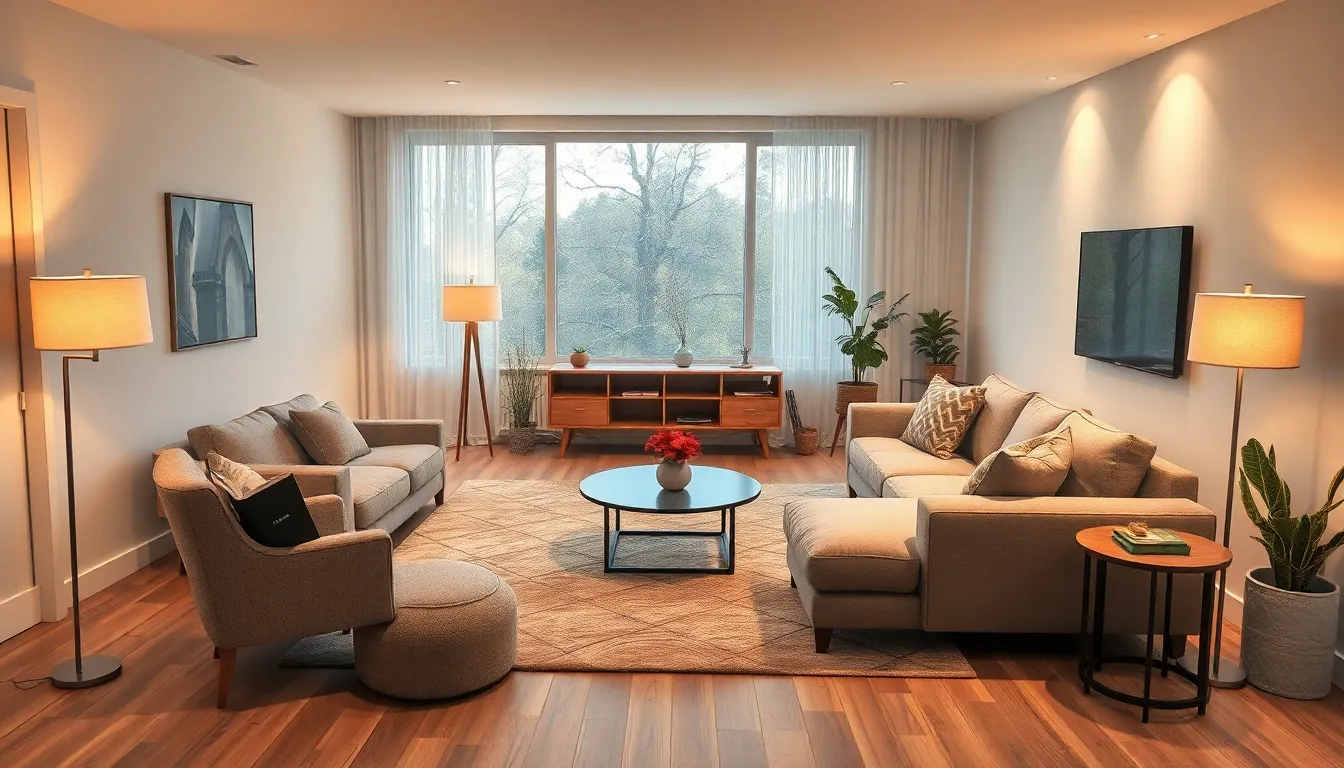
Dividing our living room into functional zones maximizes space efficiency while ensuring each area serves its intended purpose. This strategic approach transforms our single room into multiple specialized areas that enhance both form and function.
Designate a Conversation Area Around the Sofa
Positioning seating in a U-shape or circular arrangement around our sofa creates an inviting conversation area that encourages natural interaction among guests. We should place chairs and additional seating within 8 feet of each other to help comfortable conversation without raising voices.
Coffee tables or ottomans positioned centrally provide convenient surfaces for drinks and snacks while maintaining the conversational flow. Angling chairs slightly toward the sofa rather than facing straight ahead creates a more intimate and welcoming atmosphere for gatherings.
Area rugs help define the conversation zone boundaries while adding visual warmth to the space. We can use furniture placement as natural barriers, ensuring the sofa acts as an anchor point that draws people together rather than creating divisions.
Establish a Reading Nook in a Corner
Creating a cozy reading nook requires selecting a quiet corner away from high-traffic areas and entertainment distractions. We should position a comfortable armchair or chaise lounge near a window to take advantage of natural light during daytime reading sessions.
Side tables provide essential surfaces for books, beverages, and reading glasses within easy reach. Task lighting becomes crucial for evening reading, with adjustable floor lamps or table lamps offering focused illumination without disturbing other zone activities.
Bookshelves or floating shelves nearby keep favorite titles accessible while adding visual interest to the corner space. We can enhance comfort with throw pillows, blankets, and a small footstool to create our perfect reading retreat.
Set Up an Entertainment Zone Around the TV
Placing the television in a central location ensures optimal viewing angles from multiple seating positions throughout the room. We should mount the TV at eye level when seated, typically 42-48 inches from the floor, to prevent neck strain during extended viewing sessions.
Comfortable seating arranged in a semicircle or straight line facing the screen accommodates different viewing preferences and group sizes. The ideal viewing distance ranges from 6-12 feet depending on screen size, with larger screens requiring greater distances for comfortable viewing.
Cable management systems and entertainment centers keep the area organized while housing gaming consoles, streaming devices, and media collections. We can use sound-absorbing materials like curtains or upholstered furniture to improve audio quality and reduce echo in the entertainment zone.
Incorporate Statement Furniture Pieces as Focal Points
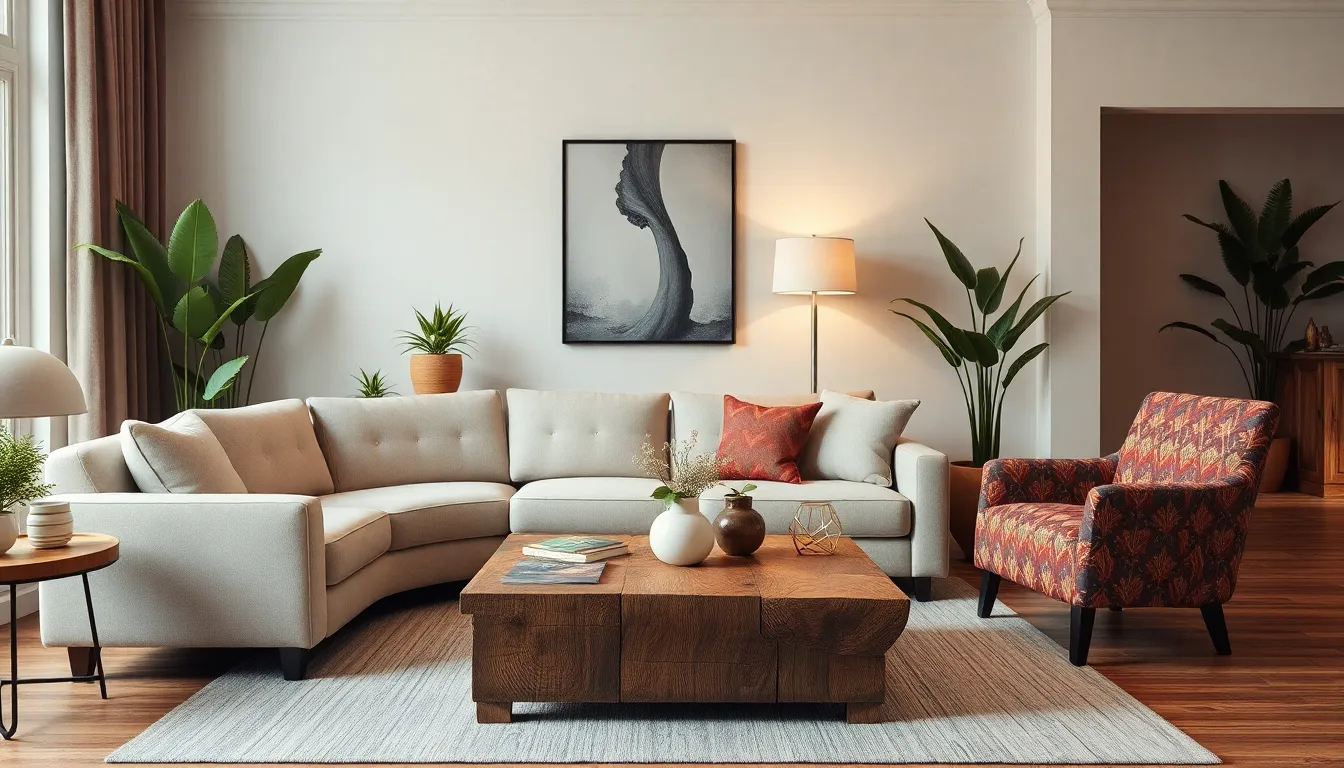
Statement furniture pieces transform our living rooms from ordinary spaces into memorable environments that reflect our personal style. These carefully chosen items become conversation starters and anchor points that define the entire room’s aesthetic.
Invest in a Quality Sofa That Anchors the Room
Curved sofas are leading the 2025 design trends, offering both exceptional comfort and sophisticated style that easily anchors any living room. Their sleek, flowing lines create visual interest while providing ample seating for family gatherings and entertaining guests.
Quality construction ensures our sofa investment lasts for years, making it worth prioritizing durability over trendy details that might quickly become outdated. We should consider the sofa’s scale relative to our room size, ensuring it provides adequate seating without overwhelming the space.
Fabric choice significantly impacts both aesthetics and maintenance, with performance fabrics offering stain resistance for busy households while natural fibers provide luxury and breathability. Color selection for our anchor piece affects the entire room’s palette, with neutral tones offering versatility and bold colors making dramatic statements.
Add a Distinctive Coffee Table
Natural materials like reclaimed wood create distinctive coffee tables that align perfectly with 2025’s emphasis on incorporating natural textures into our living spaces. These unique pieces bring warmth and character while serving as functional surfaces for drinks, books, and decorative objects.
Stone coffee tables offer another striking option, with each piece featuring one of a kind patterns and textures that become true focal points in our rooms. We can choose from materials like marble, granite, or slate to complement our existing color scheme and style preferences.
Size considerations ensure our coffee table maintains proper proportions, typically measuring about two thirds the length of our sofa and sitting 16 to 18 inches from the seating. Height should allow easy access from seated positions while providing adequate surface area for daily use.
Include Accent Chairs for Extra Seating and Style
Accent chairs bring both additional seating capacity and vibrant personality to our living rooms through bold colors and unique designs that enhance the space’s overall character. These versatile pieces can serve multiple functions, from extra seating during gatherings to cozy reading spots for quiet moments.
Strategic placement creates layered seating arrangements that improve room functionality while adding visual depth and interest to our furniture layout. We can position accent chairs to help conversation, provide intimate seating areas, or create reading nooks in underutilized corners.
Bold patterns and textures on accent chairs inject personality without overwhelming the space, especially when we balance them against more neutral anchor pieces like our sofa. Swivel chairs offer additional flexibility, allowing us to easily redirect seating toward different focal points like the fireplace or entertainment area.
Mixing different chair styles creates an eclectic, collected over time aesthetic that feels more personal and interesting than perfectly matched furniture sets.
Layer Lighting for Ambiance and Functionality
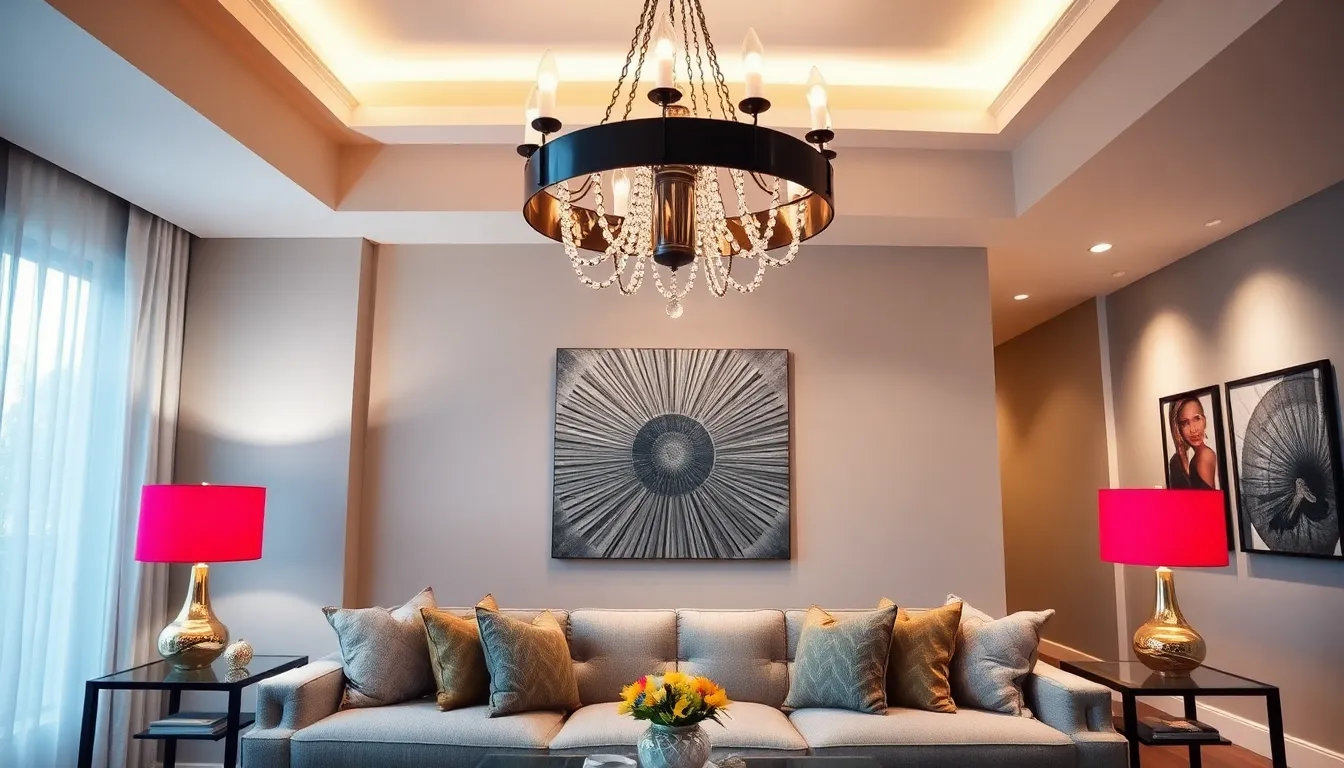
Well-designed lighting elevates our living room from ordinary to extraordinary by combining different types of illumination. We’ll create a sophisticated lighting scheme that serves both practical needs and aesthetic goals through strategic layering.
Install Overhead Lighting for General Illumination
Overhead lighting provides the foundation for our room’s illumination and makes navigation effortless throughout the space. Ceiling fixtures like chandeliers create dramatic focal points while offering broad light distribution that reaches every corner. We can choose from recessed lighting for modern minimalist looks or statement pendant lights that double as decorative elements.
Dimmers transform overhead lighting into versatile tools that adapt to different moods and activities throughout the day. Installing dimmer switches allows us to adjust brightness levels from bright task lighting during cleaning to soft ambient glow for evening relaxation. This flexibility ensures our overhead lighting works harmoniously with other light sources in our layered lighting approach.
Add Table and Floor Lamps for Task Lighting
Table lamps positioned near seating areas provide focused illumination perfect for reading or detailed work without straining our eyes. We’ll place these lamps on side tables next to sofas and chairs where we spend time with books or laptops. Floor lamps offer similar task lighting benefits while requiring no surface space and can be easily repositioned as our needs change.
Strategic placement of task lighting eliminates shadows and dark spots that make activities uncomfortable or difficult. Adjustable floor lamps with swing arms or pivoting heads direct light exactly where we need it most. These portable lighting answers let us customize illumination for exact tasks while maintaining the room’s overall design aesthetic.
Use Accent Lighting to Highlight Architectural Features
Accent lighting creates visual drama by drawing attention to our room’s most beautiful elements like artwork, fireplaces, or built-in shelving. Picture lights mounted above paintings or photographs ensure these pieces receive proper illumination that enhances their colors and details. Wall sconces positioned near architectural features like exposed beams or stone walls add depth and texture to our space.
Spotlights strategically aimed at decorative objects or plants create focal points that guide the eye around the room in pleasing patterns. We can use LED strip lighting behind furniture or under shelves to create subtle background glow that adds sophistication without overwhelming other light sources. This layered approach to accent lighting transforms flat walls into ever-changing surfaces that contribute to our room’s overall ambiance.
Optimize Your Layout for Traffic Flow
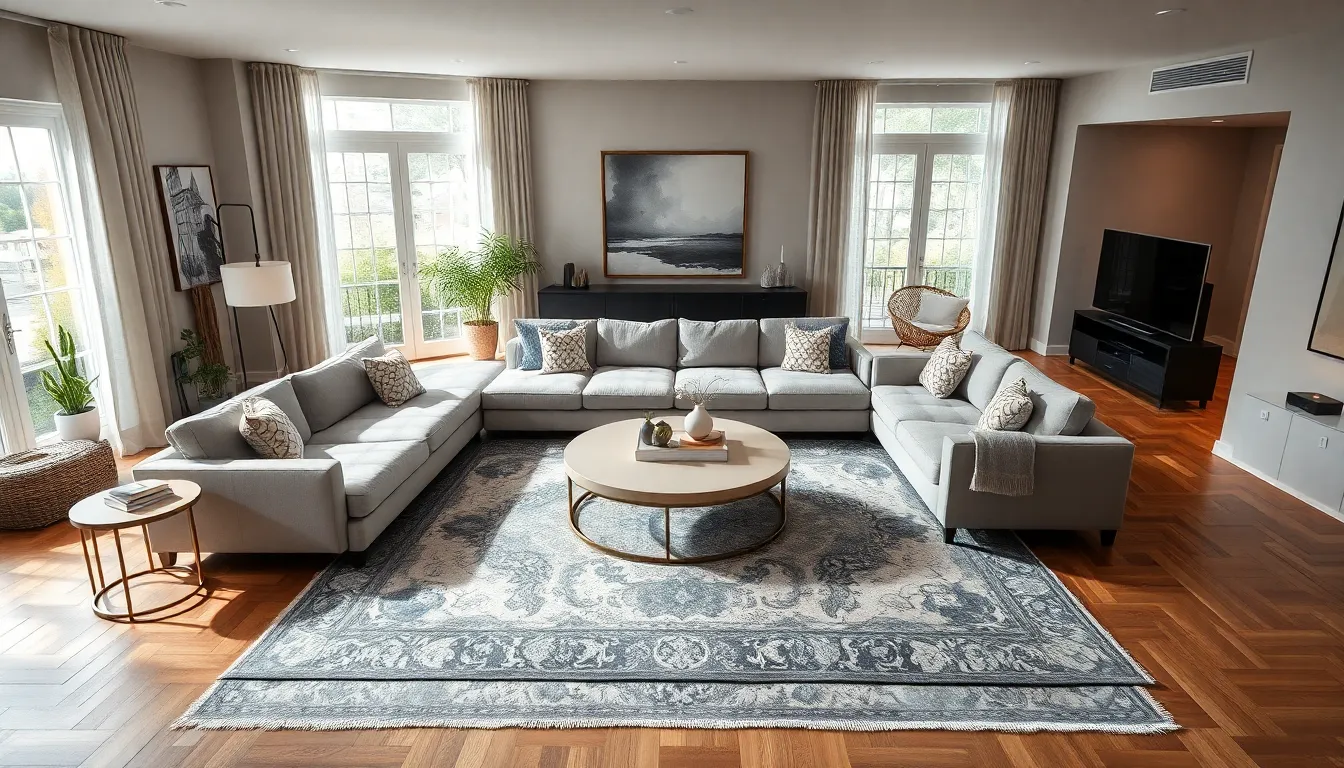
Effective traffic flow transforms your living room from a beautiful space into a functional one that serves your family’s daily needs. We’ll explore strategic furniture placement techniques that ensure seamless movement while maintaining the room’s aesthetic appeal.
Keep Pathways Clear and Wide Enough
Maintain pathways that measure at least 24 inches wide to prevent congestion and ensure comfortable movement throughout your living room. This width allows two people to pass each other without awkward maneuvering around furniture pieces.
Float furniture away from walls when working with smaller spaces to create the illusion of more room while improving traffic patterns. This technique prevents furniture from blocking natural walking routes and opens up the entire floor plan.
Position larger furniture pieces like sofas and entertainment centers first, then arrange smaller items around these anchor points to maintain clear sight lines and movement corridors.
Remove obstacles from high traffic areas by relocating decorative items, plants, or occasional tables that might create bottlenecks during daily activities.
Arrange Furniture to Encourage Conversation
Create conversation areas using L-shaped or circular furniture arrangements that naturally draw people together and help face to face interaction. This setup works particularly well when you place sofas and chairs at angles rather than pushing them against walls.
Establish dual seating zones within larger living rooms to accommodate different activities simultaneously, such as reading in one area while others watch television in another section.
Position seating pieces within 8 feet of each other to maintain comfortable conversation distance without requiring raised voices or awkward leaning forward.
Use coffee tables or ottomans as central gathering points that provide surfaces for drinks, books, and games while serving as natural focal points for your seating arrangement.
Ensure Easy Access to All Seating Areas
Define different zones with layered rugs that visually separate spaces while ensuring each seating area remains accessible and functionally distinct from neighboring areas.
Use corner spaces effectively by creating reading nooks or small workspaces that make every part of your room accessible and purposeful rather than leaving dead zones.
Leave approximately 18 inches of space between your sofa and coffee table to allow easy access for sitting down and standing up without bumping into furniture.
Create multiple entry points to each seating area so family members and guests can approach chairs and sofas from different directions without disrupting others already seated.
Add Personality Through Wall Decor and Art
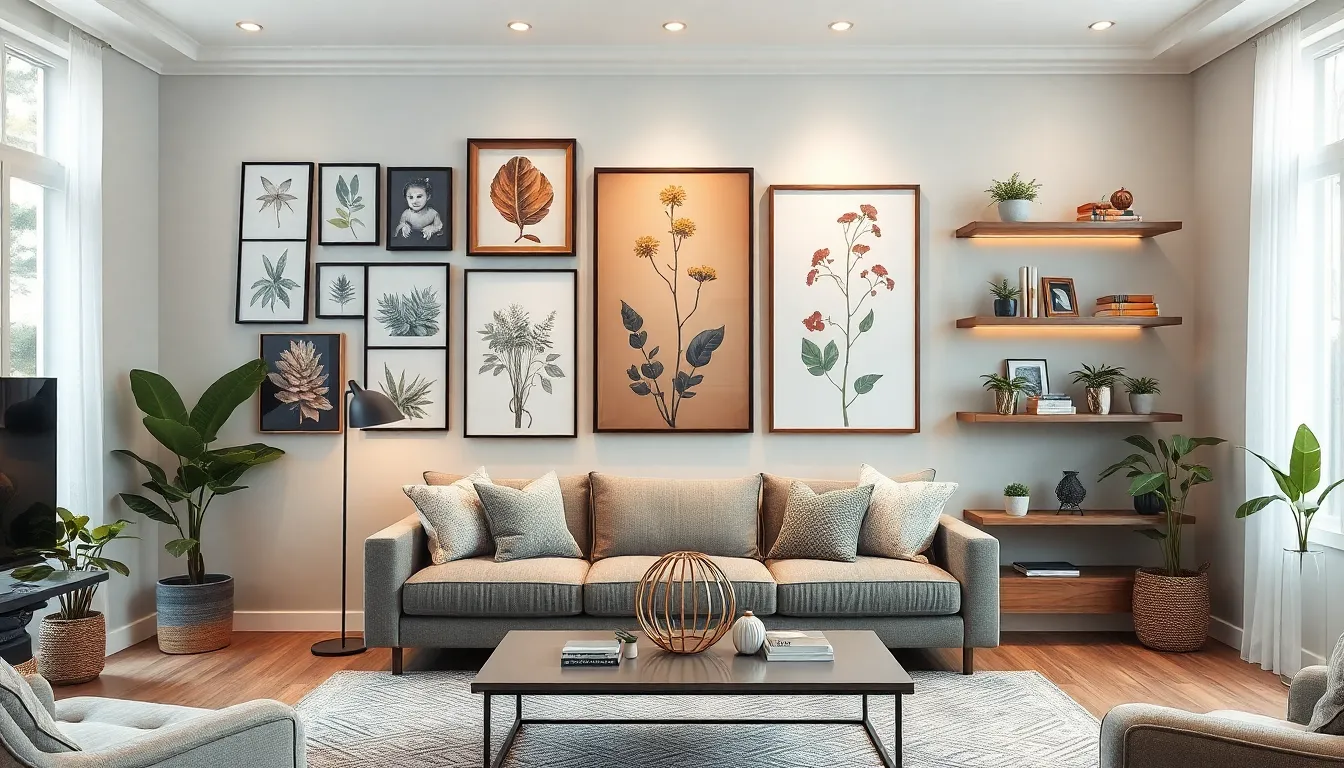
Wall decor transforms living spaces from functional rooms into personal sanctuaries that reflect our unique style and interests. These carefully chosen elements create visual narratives that make our homes feel truly lived-in and loved.
Create a Gallery Wall with Your Favorite Pieces
Gallery walls offer the perfect opportunity to showcase our most treasured memories and artistic preferences in one cohesive display. We can combine photographs, prints, and small sculptures to create a visual story that evolves with our lives and experiences.
Starting with our favorite pieces makes the selection process more manageable and ensures the final arrangement feels authentic to our personality. Mixed media combinations work exceptionally well, allowing us to blend family photos with vintage posters, botanical prints, and meaningful artwork we’ve collected over time.
Proper spacing becomes crucial for gallery wall success, with 2-3 inches between frames creating the most pleasing visual flow. We recommend laying out the entire arrangement on the floor first, experimenting with different configurations until we find the perfect balance of colors, sizes, and styles.
Template guides help ensure our gallery wall maintains professional proportions while reflecting our personal aesthetic preferences. Paper templates cut to frame sizes let us test arrangements directly on the wall before committing to nail holes.
Use Large Statement Art as a Focal Point
Statement art pieces command attention and instantly establish the room’s design direction with bold visual impact. Oversized paintings or striking photography can anchor our entire color scheme while creating conversation starters that guests remember long after their visit.
Strategic placement above the sofa or fireplace maximizes the artwork’s impact without overwhelming the space’s other design elements. We should ensure the piece measures approximately two-thirds the width of the furniture below it for optimal visual balance.
Color coordination between statement art and existing decor creates harmony, though contrasting pieces can add exciting visual tension when done thoughtfully. Bold artwork works particularly well in neutral rooms, providing the perfect pop of personality without clashing with established color palettes.
Investment in quality pieces pays dividends over time, as statement art often becomes the room’s defining characteristic that influences future decorating decisions. We can find affordable options through local artists, online galleries, or even large-scale photography prints that capture meaningful moments or places.
Incorporate Floating Shelves for Display and Storage
Floating shelves provide versatile answers for showcasing our favorite objects while maintaining the clean lines that modern living room design demands. These streamlined storage options keep surfaces organized while creating opportunities to display books, plants, collectibles, and rotating seasonal decor.
Installation at varying heights creates visual interest and accommodates different sized objects, from small succulents to larger coffee table books. We can arrange items using the rule of threes, grouping objects in odd numbers for the most pleasing aesthetic results.
Mixing functional and decorative items ensures our shelves serve both practical and visual purposes throughout daily life. Small baskets can hide remote controls while beautiful ceramics and art books add sophistication to the display.
Regular rotation of displayed items keeps our living room feeling fresh and allows us to highlight different collections throughout the year. This approach lets us enjoy more of our treasured possessions without creating visual clutter that overwhelms the space.
Strategic lighting underneath floating shelves illuminates displayed objects and creates ambient lighting that enhances the room’s overall atmosphere during evening hours.
Bring Nature Indoors with Plants and Natural Elements
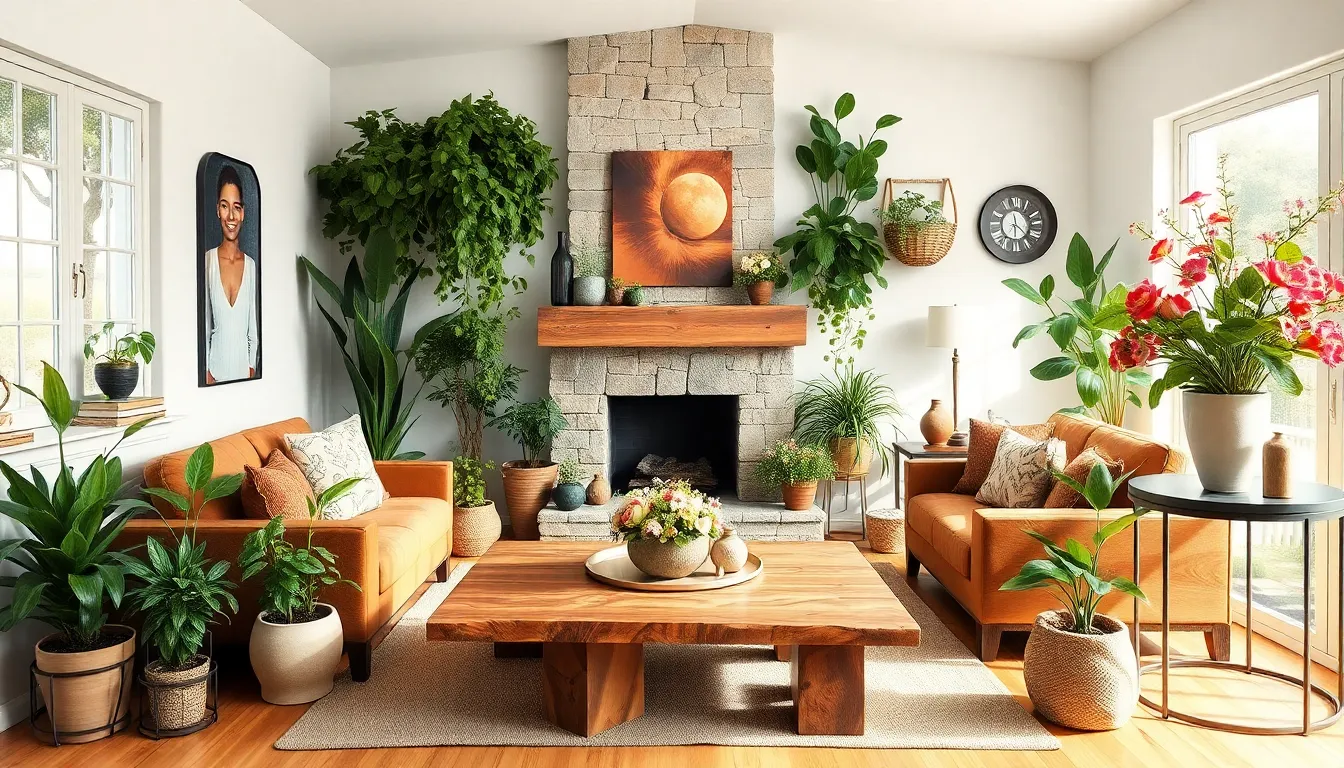
Incorporating plants and natural elements into living room design creates a vital connection with nature while improving the aesthetic appeal of your space. This key trend for 2025 transforms your room into a refreshing sanctuary that promotes wellbeing and visual interest.
Choose Low-Maintenance Houseplants
Succulents offer the perfect solution for busy households seeking greenery without extensive care requirements. These hardy plants thrive in indoor conditions and require watering only once or twice per week, making them ideal for beginners or those with demanding schedules.
Air plants provide another excellent low-maintenance option that literally lives on air and occasional misting. Position them in decorative holders or hang them from the ceiling to create floating green accents throughout your living room.
Snake plants deliver vertical drama while tolerating neglect and low light conditions better than most houseplants. Their architectural leaves complement modern furniture styles and can grow up to four feet tall, creating natural room dividers.
Pothos vines cascade beautifully from shelves or hanging planters and adapt to various lighting conditions while requiring minimal attention. Trim them regularly to maintain desired lengths and propagate cuttings to expand your collection at no extra cost.
Incorporate Natural Materials Like Wood and Stone
Wood furniture adds instant warmth and texture to living rooms while providing durability that lasts for decades. Choose pieces made from reclaimed wood for coffee tables, side tables, or media consoles to introduce sustainable elements with unique character marks and grain patterns.
Stone elements create striking focal points when incorporated into walls or fireplace surrounds. Natural stone textures like slate, limestone, or river rock bring outdoor aesthetics indoors while providing thermal mass that helps regulate room temperature.
Wooden accent walls transform plain surfaces into dramatic backdrops using shiplap, barn wood, or geometric wood panels. Install these behind sofas or entertainment centers to create visual anchors that define seating areas.
Stone decorative objects serve as sculptural elements when placed on coffee tables, shelves, or mantels. Select pieces like geodes, polished river rocks, or carved stone bowls to add natural beauty without overwhelming your existing decor scheme.
Add Fresh Flowers for Seasonal Color
Seasonal flower arrangements provide vibrant focal points that can be updated throughout the year to reflect changing themes and color palettes. Spring tulips and daffodils brighten spaces after winter, while autumn chrysanthemums and marigolds complement warm color schemes.
Fresh flowers in varying heights create ever-changing displays when arranged in groups of three or five containers across coffee tables, side tables, and mantels. Mix tall gladioli with medium height roses and short pansies to establish visual rhythm and depth.
Weekly flower rotations keep your living room feeling fresh while allowing you to experiment with different color combinations and seasonal varieties. Purchase flowers from local farmers markets to support community growers while ensuring maximum freshness and longevity.
Strategic flower placement draws attention to key areas like entryways, conversation zones, and entertainment centers. Position larger arrangements where they won’t obstruct sight lines or interfere with daily activities while still providing maximum visual impact.
Maximize Storage with Stylish Solutions
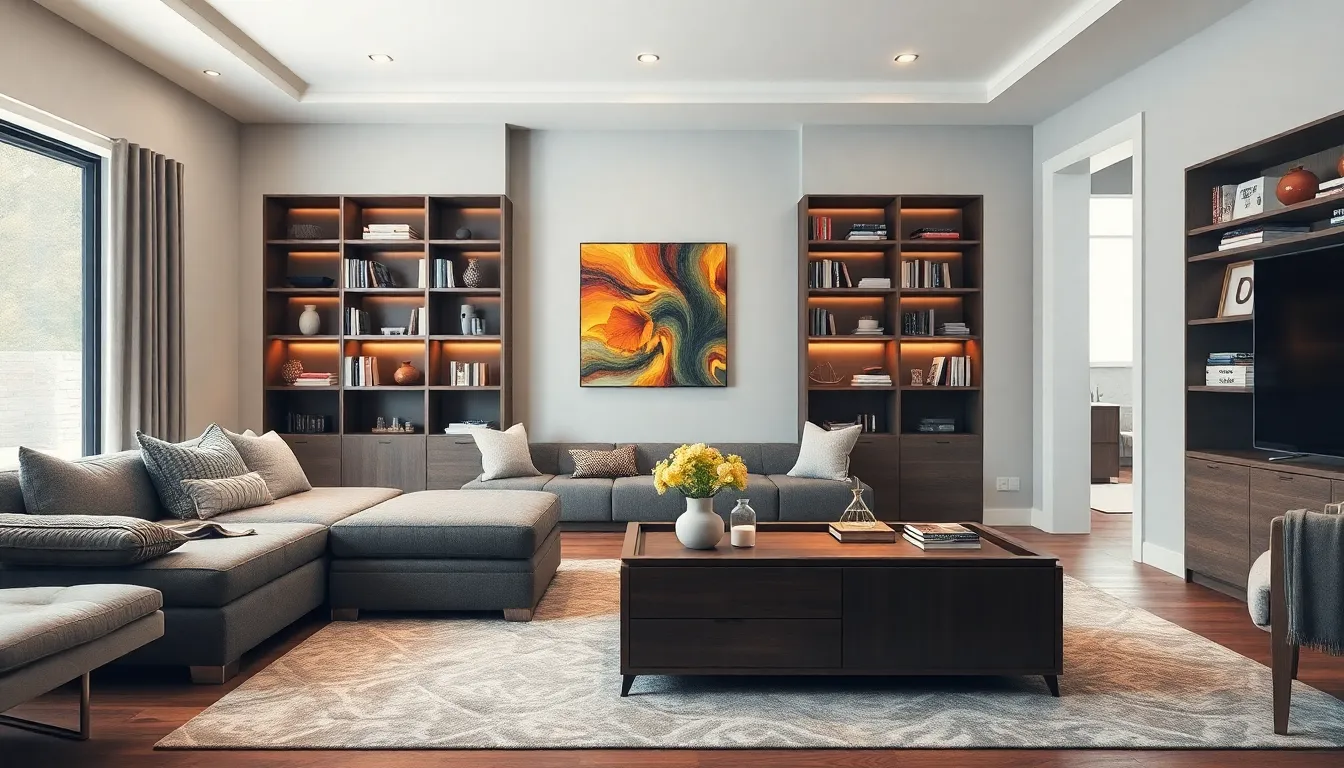
We can transform our living rooms into organized, beautiful spaces by incorporating storage answers that enhance rather than compromise our design aesthetic. Modern storage approaches blend seamlessly with interior design to create functional yet visually appealing environments.
Use Ottoman Storage for Hidden Organization
Ottoman storage pieces serve dual purposes by providing comfortable seating or footrests while discreetly housing essential items. These versatile furniture pieces can store blankets, toys, media equipment, and seasonal items without creating visual clutter in our living spaces. We’ll find ottomans particularly valuable in small rooms where every piece must maximize functionality.
Families benefit significantly from ottoman storage answers since they offer quick access to frequently used items while maintaining a tidy appearance. Round ottomans work well in conversation areas, while rectangular options complement sectional sofas and provide additional surface space for drinks or books.
Install Built-in Shelving Units
Built-in shelving units efficiently use vertical space while offering customizable compartments for books, décor, and media collections. We can tailor these installations to our room’s exact dimensions, creating a unified appearance that blends storage with design seamlessly. Adjustable shelves accommodate items of different sizes, from small decorative objects to large storage baskets.
Closed cabinets and open shelving combinations provide the perfect balance between display and concealment, helping us maintain a clutter-free environment. Materials and finishes should match our existing décor to ensure cohesion throughout the space. Built-in units don’t occupy excess floor area, making them ideal for maximizing storage without overwhelming our living room’s footprint.
Choose Furniture with Dual-Purpose Storage
Coffee tables with lift-tops offer hidden storage compartments perfect for board games, electronics, or linens while serving as functional surface space. We can select sofas equipped with built-in drawers that provide additional storage without sacrificing comfort or style. These multifunctional pieces reduce visible clutter and enhance our room’s overall usability.
Dressers or buffets work excellently as stylish alternatives to traditional TV stands, adding both storage capacity and surface area for decorative elements. Entertainment centers with integrated storage keep media equipment organized while maintaining clean lines and sophisticated aesthetics. We should prioritize furniture pieces that serve multiple functions to maximize both storage and style in our living room design.
Conclusion
We’ve explored many ways to transform your living room into a space that truly reflects your personality while serving your daily needs. From strategic color choices and lighting layers to functional zoning and clever storage answers these design principles work together to create environments that enhance your lifestyle.
Remember that successful living room design doesn’t require a complete overhaul or massive budget. Small thoughtful changes like repositioning furniture for better flow or adding plants for natural warmth can make dramatic differences in how your space feels and functions.
Your living room should tell your story while providing comfort for both everyday moments and special gatherings. By implementing these design strategies you’ll create a space that not only looks beautiful but also supports the way you actually live and entertain.
Frequently Asked Questions
What is the most important element when designing a living room?
A cohesive color palette serves as the foundation for successful living room design. Start by selecting a primary color scheme that reflects your personal style, then incorporate accent colors through accessories, artwork, and textiles. This approach creates visual harmony and makes the space feel intentional and well-designed.
How can I make my living room appear larger and brighter?
Maximize natural light by positioning mirrors strategically to reflect light throughout the room and using light-colored window treatments. Additionally, choose a light color palette for walls and furniture, and ensure proper traffic flow by arranging furniture to create open pathways through the space.
What are functional zones and how do I create them in my living room?
Functional zones are designated areas within your living room that serve specific purposes, such as conversation areas, reading nooks, or entertainment zones. Create these by grouping furniture strategically, using area rugs to define spaces, and positioning lighting to support each zone’s intended function.
How do I choose the right statement furniture pieces?
Focus on quality over quantity when selecting statement pieces. Invest in a well-made sofa as your primary focal point, then add character with distinctive coffee tables or accent chairs. Choose pieces that complement your color palette while reflecting your personal style and providing both comfort and visual interest.
What’s the best approach to living room lighting?
Layer different types of lighting to create a sophisticated environment. Combine ambient lighting (overhead fixtures), task lighting (reading lamps), and accent lighting (decorative fixtures) to provide functionality while enhancing the room’s ambiance. This approach allows you to adjust lighting based on different activities and moods.
How can I add personality to my living room without major renovations?
Incorporate wall decor and art to reflect your personal style. Create gallery walls with a mix of artwork, photographs, and decorative objects. Add floating shelves to display collections and books. These elements allow you to showcase your personality while maintaining design cohesion throughout the space.
What are the best low-maintenance ways to bring nature indoors?
Choose hardy houseplants like snake plants, pothos, or rubber trees that require minimal care. Incorporate natural materials through wooden furniture, woven textures, or stone accents. These elements enhance aesthetic appeal while creating a calming, organic atmosphere without demanding extensive maintenance.
How can I maximize storage without compromising style?
Invest in dual-purpose furniture like ottoman storage, which provides hidden organization while serving as seating or footrests. Use built-in shelving units to maximize vertical space efficiently. Choose storage solutions that complement your design aesthetic, ensuring functionality doesn’t sacrifice your living room’s overall visual appeal.

